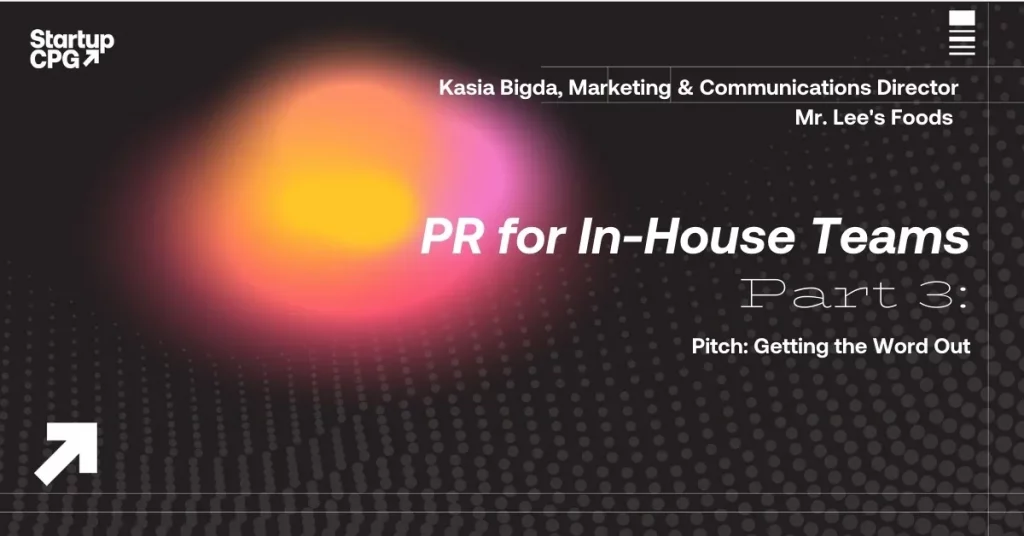PR for In-House teams –
Part 3: Pitch: Getting the Message out!
Kasia Bigda is the Marketing and Communications Director at Mr Lee’s Pure Foods – global food tech company. Prior to joining Mr Lee’s she worked at multiple digital marketing agencies focusing on SEO and content marketing. She loves travelling, nature and psychology.
In my previous articles I covered the preparation stage of your media kit and how to find the right angle to pitch different types of publications. This time I will give you an insight of how I am getting the message out for Mr Lee’s, will cover some useful PR tools and give you a few tips to prevent you from making the same mistakes I did!
So let’s start with the essentials. You will need:
Title of the email
Brief intro to put into email which would include:
- short copy about the brand and about your product/s
the retail price of your product - where to buy
- your website link
- your brand name and product name
Images
A press release or a comment
How to pitch with a press release:
Press release is usually written when there is some news to share eg. product launch, listing with a new retailer, some exciting partnership, new NPD etc. You can use the title of the press release as the subject of the email (you may shorten it up a bit if needed) eg. “Mr Lee’s launches UK’s 1st congee – savoury rice porridge”.
Into the email’s body I am usually adding 2-4 paragraphs of copy briefly describing: the brand, then the product (how I want it to be featured in case they just “copy and paste” it) and then I am referring to the press release for more details.
Recently I have started adding a link to Google Drive where my press release is saved and also a link to the images which I want them to use, instead of attaching them to the email. I am simply adding a sentence “Please find the press release here (anchored link) and images here (anchored link)”.
There are 2 other ways to do it:
- Adding the press release and images as an attachment.
- Pasting them into the email body.
Personally I prefer to keep the attachments outside of the email and just add anchored links to Google Drive. It helps me to keep the content of the email brief and to the point. Just make sure you give them access to it, so check out the settings of the link on the Google Drive/Dropbox before sending it out.
It is also very useful to include the retail price of your product, info on where to buy (if you are listed in any national supermarket chain it will be much easier to get some big titles, as they want to make it easy for their readers to buy it), your website link, your brand name and product name.
I also like to paste the best image or two to the email underneath the copy, so they are hopefully enticed by what they see and have a better idea about my products.
If you can, offer to send them your product’s samples to try; then hopefully it will speak for itself!
How to pitch a comment or a feature
Same rules apply to pitching any comments you want to make or if you just want to feature your product. For a callout for a comment on a particular topic or for a specific product type I usually reply with a 2-4 paragraphs intro on who we are and why we are suitable to comment, or why our product is the right fit. It is also helpful to highlight the USPs and the angle eg. if they are looking for vegan options make sure you highlight that aspect in the intro and title eg. “Vegan lunches ready in 3 minutes – Mr Lee’s Noodles”.
If you pitch a quote, then actually add it to your email! This way if the journalists have no time to reply to everyone but want to use your quote, they will just feature you, as they already have the right content in hand. For the quote 3-4 sentences should be enough as a teaser. Close it with a suggestion, that if they are interested to hear more, you are happy to answer more questions via email or phone.
Make sure you are having a spreadsheets setup to keep track of your pitches with the name of the publication, name and email of the journo you pitched, the date of the pitch, the chase date, what angle did you pitch and any notes eg. with outcome, samples requests etc.
What if you don’t hear back? Can you chase the journalist?
If the journalist wants to feature you, you usually hear from them within 1-3 days asking for more details or thanking you for the content if they got everything. Sometimes they may just feature you without any communication back, as they had all the info they needed within your email. And sometimes absolutely nothing happens…
Can you chase them then? Absolutely! But…I would not chase the journo more than once, as if they are interested, they would reply after the chase. Don’t pester them with emails, as you can burn the bridges, so just let it go and try again another time. Often they want a selection of opinions or different product types. Perhaps the “category” you would belong to had been filled in by another small brand and they want a variety of points of view. Or they may have saved your content for later, as they have a more suitable theme coming in the future. Or simply you have just not been suitable for that particular piece.
What tools can I use to get the leads?
Being on budget has its limitations (what a line..daaah!), so many of the bigger PR tools were out of our reach for us, yet with the list I created below, you should have everything you need to start on a low or no budget. They will help you to find out what journos are looking for at the moment and provide a much better success rate than direct pitching (at least based on my experience). I will discuss them in more detail in my next article.
- HARO – free (basic)/paid – targets USA
- Sourcebottle– free (basic)/paid – targets Australia, but also UK and USA
- Response Source– paid – targets UK (also France to some extent)
- Twitter hashtag #journorequest – free – targets UK
What to look out for:
- National press does not usually like to cover something that other titles have covered recently, so bear that in mind. Nobody likes to spread old news, so if your news have been recently covered in eg. The Times, there is less of a chance that another big national newspaper will cover your story a couple of days later.
- Monthly magazines are very interesting due to the specific nature of them. They have longer lead times, so if you want to be featured in the May issue (which often is released mid April), you need to probably be approaching them around January/February if not earlier! Weekly magazines have a few weeks lead time and due to their frequency, you statistically have a bigger chance to get featured.
- If you are successful (and I hope you will be!) don’t expect to be featured in the same magazine month after month though. Very rarely customer magazines are featuring the same products in their following issues (unless these are paid features – advertorials). They simply do not want to suffocate the readers with the same brands. So if you got featured and want to repeat it, you can always try to find a different angle eg. comment or interview, different products to get featured again, competition etc. or try a few months later.
- Local press likes to hear news from local companies, so this is definitely a low hanging fruit you should explore. Most of the time they should be interested in your news if it is relevant to their local readers.
I hope it was helpful and don’t forget to tune into my next article for more tips!
Good luck!






All Comments